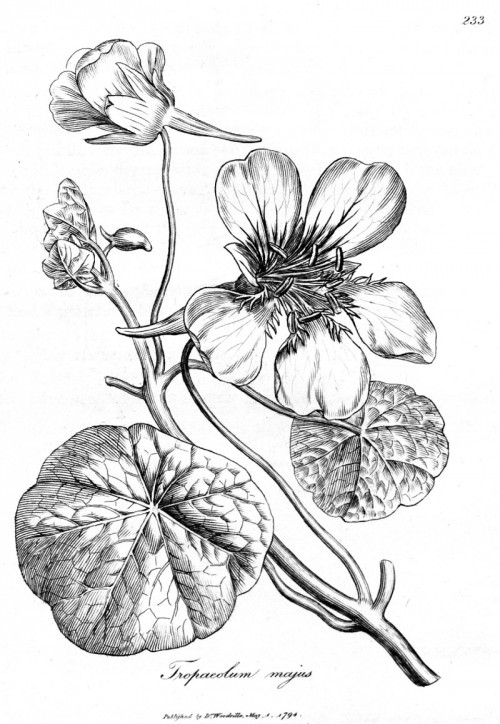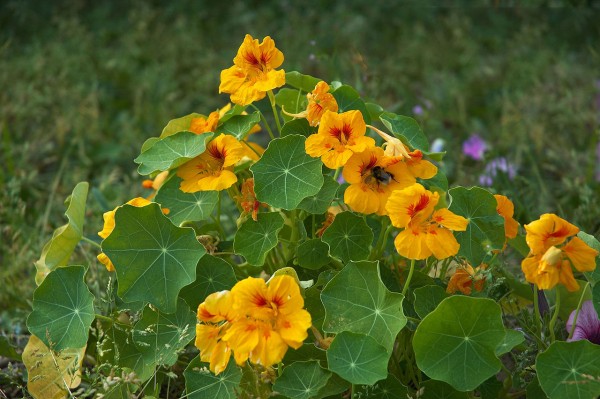Dies ist eine alte Version des Dokuments!
Tropaeolum majus L. - Tropaeolaceae - Indian cress, (garden) nasturtium, (Große) Kapuzinerkresse
Annual (tropic perennial) herb, creeping and climbing, only known cultivated, probable hybrid origin tropical South America, naturalized and cultivated elsewhere; leaves orbicular; flowers orange to red.
„It is widely cultivated, both as an ornamental plant and as a medicinal plant… All its parts are edible. The flower has most often been consumed, making for an especially ornamental salad ingredient; it has a slightly peppery taste reminiscent of watercress, and is also used in stir fry. The flowers contain about 130 mg vitamin C per 100 grams (3.5 oz), about the same amount as is contained in parsley. Moreover, they contain up to 45 mg of lutein per 100 gr, which is the highest amount found in any edible plant.“
http://en.wikipedia.org/wiki/Tropaeolum_majus
„Tropaeolum is used as a natural antibiotic to treat infections of the urinary tract and respiratory tract. It is applied topically against various fungal infecions,including candida and as a counter-irritant in case of muscle pain.“
[Medicinal Plants of the World. Ben-Erik Van Wyk and Michael Wink, Pretoria 2004, 326]
The application of nasturtium is a possible way out of antibiotic overuse in industrial breeding of pigs: „Nasturtium (Tropaeolum majus L.) is a herb with a proven antimicrobial activity, which is caused by benzyl-isothiocyanate the degradation product of glucotropaeolin. In an experiment with piglets, direct and graded supplementation of T. majus with the feed was performed over a period of five weeks. T. majus was supplemented at an upper dosage of 1 g/kg with the feed, equaling 48.7 mg/kg glucotropaeolin, which resulted in a benzyl-isothiocyanate concentration in the urine of up to 16 μmol/L, which ought to be high enough to control a broad range of bacteria. Up to 7.3 % of the glucotropaeolin taken up by the animals was excreted as bioactive benzyl-isothiocyanate. Supplementation with T. majus had no effect on growth performance of piglets.“
[Influence of Tropaeolum majus supplements on growth and antimicrobial capacity of glucotropaeolin in piglets., Bloem, E., Berk, A., Haneklaus, S., Selmar, D., Schnug, E., Landbauforschung Volkenrode, Vol.58(3), 2008, 203-210]
http://citeseerx.ist.psu.edu/viewdoc/download?doi=10.1.1.322.3915&rep=rep1&type=pdf#page=63
„Indian cress (Tropaeolum majus L.) has been consumed in salad or soup for decades… we report on the study of the odorant profile and odor-impact compounds of Indian cress absolute… Forty-four odorant compounds were identified among which 22 (50% of the identified odorant molecules) were identified… These trace compounds were not detected by 1D-qMS or could only be found with specific searches once they were detected by comprehensive 2D-GC, although they were well perceived by the judges in GC-O. This was amongst others the case for the two molecules having the highest odor impact, (E)-hex-2-enal (fruity) and diethyl trisulfide (alliaceous, sulfury, cabbage). A powerful sulfur-containing odor compound whose first identification in cress was recently reported by the authors was detected by GC-O: O,S-diethyl thiocarbonate (fruity/red fruit and sulfury odor).“
[Characterization of volatile compounds of Indian cress absolute by GC-olfactometry/VIDEO-sniff and comprehensive two-dimensional gas chromatography., Breme, K., Tournayre, P., Fernandez, X., Meierhenrich, U. J., Brevard, H., Joulain, D., Berdague, J.L., Journal of agricultural and food chemistry, Vol.58(1), 2009, 473-480]

Woodville, W., Medical botany, vol.4, t.233 (1794)
http://plantgenera.org/species.php?id_species=1038247

picture source Wouter Hagens, wikimedia commons
